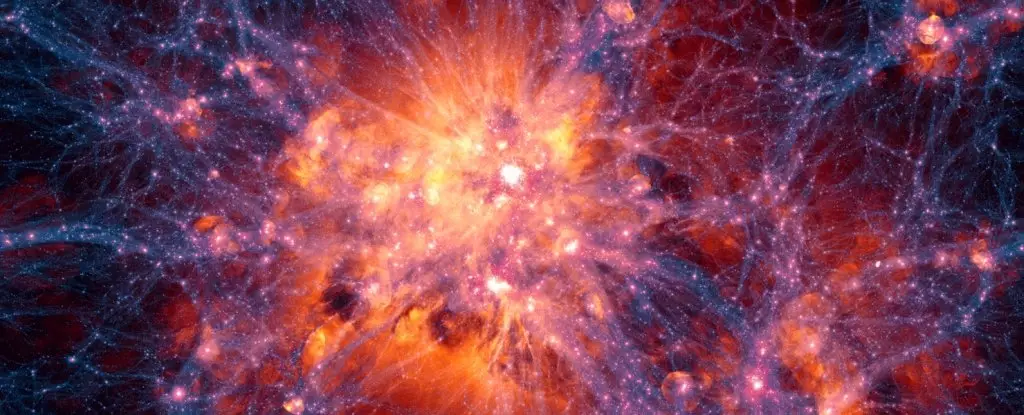More than a century after Albert Einstein introduced his theory of general relativity, a remarkable validation of his revolutionary concepts has emerged from the cosmos. A colossal collaboration of astronomers has recently mapped approximately 6 million galaxies, providing insights that span 11 billion years of the Universe’s history. This massive undertaking serves not merely to reinforce Einstein’s vision but also to illuminate the intricate ways gravity shapes the structure of the universe. As cosmic expansion continues relentlessly, gravity counteracts this force, pulling matter into intricate strands known as the cosmic web. The new findings reveal how closely the observed behavior of these galaxies aligns with Einstein’s predictions, underscoring the enduring relevance of his theories.
Cosmologist Pauline Zarrouk, representing the French National Center for Scientific Research, emphasized the need to test general relativity beyond the confines of our solar system. She pointed out the significance of examining galaxy formation rates as a direct method to validate theoretical predictions at vast cosmological scales. The observations not only confirm the framework that Einstein laid out but also challenge scientists to probe further into the nature of gravity and its consequences. One of the profound mysteries lies in understanding gravity, an unseen but powerful force that dictates the motions of celestial bodies without us fully grasping its nature or origin. This ongoing quest for knowledge is what drives cosmologists to continually evaluate and refine the models that describe our Universe.
At the heart of these discoveries is the concept of the cosmic web, a vast network formed by gravitational fields and dark matter. This web structures the observable universe, influencing how galaxies are distributed throughout space. The findings from the Lawrence Berkeley National Laboratory-led Dark Energy Spectroscopic Instrument (DESI) indicate that as galaxies grow and evolve, their distribution is remarkably consistent with Einstein‘s general relativity. Any deviations from this predicted structure could indicate new physics beyond our current understanding, making this exploration all the more critical.
The analysis conducted by the DESI Collaboration focuses on the meticulously gathered data from the initial year of the instrument’s operations. By surveying 5.7 million galaxies and quasars, researchers have constructed a detailed landscape of cosmic evolution that dates back to the early Universe, approximately 11 billion years ago. This unprecedented survey forms a foundation for our understanding of how gravity interacts across vast distances and time scales.
Dark Matter and Dark Energy: The Unseen Forces
The investigation into the cosmic web does not merely reinforce classical theories; it also opens new avenues to explore enigmatic concepts such as dark matter and dark energy. These two components constitute about 95 percent of the Universe, yet their nature remains shrouded in mystery. Dark matter, which contributes to gravitational forces, and dark energy, responsible for the accelerated expansion of the Universe, are pivotal elements in our understanding of cosmic dynamics.
Mark Maus, a physicist associated with the Lawrence Berkeley National Laboratory and the University of California, Berkeley, remarked on the staggering prospect of tackling such fundamental questions. He highlighted the significance of being able to visualize the cosmos while grappling with these profound mysteries. As ongoing analyses are conducted, researchers aim not only to refine models of gravitational behavior but to discern the fundamental constituents that govern the cosmos.
With data collection ongoing and the DESI instrument gradually amassing information on more than 40 million galaxies and quasars, future revelations seem inevitable. The goal extends beyond validating existing theories; it is to enhance our understanding of the relationships between gravity, cosmic structure, and the dark forces that dictate the Universe’s fate.
The latest results derived from this expansive survey represent just the beginning of a long, complex journey into the depths of the cosmos. As the research unfolds and more publications emerge, the implications of these findings promise to reshape our comprehension of not only gravity but also the fundamental fabric of reality itself. By analyzing the growth and distribution of cosmic structures, scientists are poised to unravel new layers of complexity in the Universe, potentially rewriting foundational principles in theoretical physics.
In summation, Einstein’s theories resist obsolescence. The performance of general relativity, confirmed across billions of years and immense cosmic distances, substantiates its status as a cornerstone of modern physics. As researchers continue to probe the Universe’s hidden layers, they not only verify the past but also embark on an exciting journey to uncover what lies ahead in the boundless expanse of space.


Leave a Reply